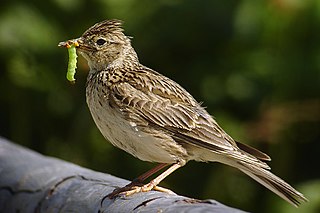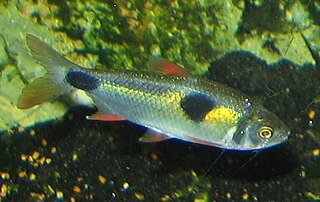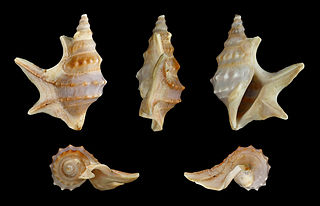
Larks are passerine birds of the family Alaudidae. Larks have a cosmopolitan distribution with the largest number of species occurring in Africa. Only a single species, the horned lark, occurs in North America, and only Horsfield's bush lark occurs in Australia. Habitats vary widely, but many species live in dry regions.

Atriplex is a plant genus of 250–300 species, known by the common names of saltbush and orache. It belongs to the subfamily Chenopodioideae of the family Chenopodiaceae. The genus is quite variable and widely distributed. It includes many desert and seashore plants and halophytes, as well as plants of moist environments. The generic name originated in Latin and was applied by Pliny the Elder to the edible oraches. The name saltbush derives from the fact that the plants retain salt in their leaves; they are able to grow in areas affected by soil salination.

The National Council is the parliament of the Principality of Monaco. The body is composed of twenty-four members, who are elected from lists by universal suffrage. Councilors serve for five-year terms, and though it may act independently of the Prince, he may dissolve it at any time, provided that new elections be held within three months.

Calliandra is a genus of flowering plants in the pea family, Fabaceae, in the mimosoid clade of the subfamily Caesalpinioideae. It contains about 140 species that are native to tropical and subtropical regions of the Americas.

Stiphodon is a genus of freshwater gobies. They inhabit swift, clear streams close to the sea and are found in large parts of Asia and Oceania. Many of the 36 currently recognized species have extremely restricted distributions on single islands or even single streams. These are small gobies with bodies squarish in cross section. A female of S. multisquamus with a standard length of 60.4mm is the largest Stiphodon individual on record.

Schismatogobius is a genus of fish in the subfamily Gobionellinae. They are native to southern and eastern Asia, Australia and the Pacific Islands. Adults dwell in freshwater habitat such as streams and rivers, where they live along the sand and gravel substrates.

Lepidophagy is a specialised feeding behaviour in fish that involves eating of scales of other fish. Lepidophagy is widespread, having been independently evolved in at least five freshwater families and seven marine families. A related feeding behavior is pterygophagy, which are fish that feed on the fins of other fish.
Lentipes is a genus of gobies native to fresh, marine and brackish waters of the Malay Archipelago and islands in the Pacific. Its species are typically from fast-flowing streams and some are anadromous.

Sicyopterus is a genus of gobies native fresh waters from Madagascar to the Pacific islands.
Sicyopus auxilimentus is a species of goby endemic to the Philippines where it is only known to occur in Lagu Lagu Creek on Leyte Island. This species can reach a length of 2.9 centimetres (1.1 in) SL.

Sicyopus is a genus of small gobies. Most are native to fast-flowing streams and rivers in Southeast Asia and Melanesia, but S. zosterophorus also occurs in China, Japan and Palau, S. nigriradiatus is restricted to Pohnpei, S. jonklaasi is restricted to Sri Lanka, and S. lord is restricted to Madagascar.
Sicyopus jonklaasi, the lipstick goby, is a species of goby endemic to Sri Lanka where they occur in rocky hill streams of swift-flowing water. They having sucking discs on their undersides with which they adhere to the sides of rocks. Newly hatched larvae are washed to the sea by heavy flows brought on by rains and mature there before returning to the streams. This species can reach a length of 4.5 centimetres (1.8 in) TL. It can also be found in the aquarium trade.

Stenogobius is a genus of fish in the goby subfamily, Gobionellinae. They are native to fresh, brackish and marine waters along the coasts of the Indian and Pacific Oceans. They are known commonly as coastal stream gobies.

Granulina is a genus of minute sea snails, marine gastropod mollusks or micromollusks in the family Marginellidae.

Aporrhais is a genus of medium-sized sea snails, marine gastropod mollusks in the family Aporrhaidae and the superfamily Stromboidea.
Nitrospirae is a phylum of bacteria. It contains only one class, Nitrospira, which itself contains one order (Nitrospirales) and one family (Nitrospiraceae). It includes multiple genera, such as Nitrospira, the largest. The first member of this phylum, Nitrospira marina, was discovered in 1985. The second member, Nitrospira moscoviensis, was discovered in 1995.

The Sicydiinae are a small subfamily of freshwater gobies, with only nine genera. They are usually found in fast-moving mountain streams in tropical islands. They are characterized by highly developed rounded suction discs and an amphidromous lifecycle. Adult lengths range from 2 to 15 cm. Some species are popular in the aquarium trade. The genera included under Sicydiinae are:

The Bling Ring is a 2013 internationally co-produced satirical crime film written, directed and produced by Sofia Coppola. It features an ensemble cast, led by Katie Chang, Israel Broussard, Emma Watson, Taissa Farmiga, and Claire Julien. It is based on the 2010 Vanity Fair article "The Suspects Wore Louboutins" by Nancy Jo Sales, which dealt with a real-life gang known as the Bling Ring.
Akihito is a genus of gobies native to streams in Vanuatu.
Akihito vanuatu, the Vanuatu's emperor, is a species of fish in the family Gobiidae, the gobies. It is endemic to Vanuatu, where it inhabits streams and pools. Males of this species can reach a length of 4.3 centimetres (1.7 in) SL while females can reach 3.9 centimetres (1.5 in) SL.














